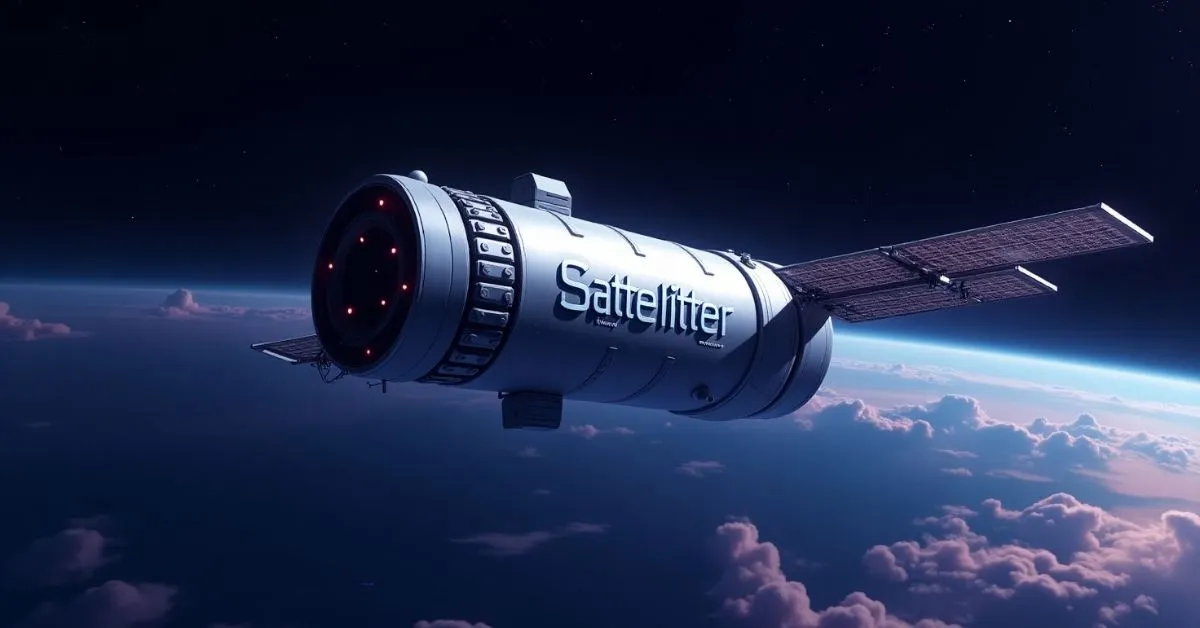In the ever-evolving world of technology, terms like “satellite” and “communication systems” are commonly used, but a new and intriguing concept has begun to rise: the “Sattelitter.” Although the term may sound unfamiliar, it’s quickly becoming a vital part of how we understand modern communication, surveillance, and data systems. Let’s take a deep dive into the world of sattelitters, exploring their capabilities, benefits, and how they will shape the future of our connected world.
What is a Sattelitter?
The term “Sattelitter” may sound like a misspelling of the word “satellite,” but it refers to an entirely new class of systems that function similarly to traditional satellites but with a crucial difference—they are not confined to space. Unlike satellites that orbit Earth, sattelitters exist in the stratosphere, on the ground, or even within drones and sensor networks. Essentially, it acts like a satellite in terms of collecting or transmitting data, but it operates in more flexible and diverse locations.
A sattelitter is part of an emerging technological ecosystem that aims to provide faster, cheaper, and more flexible communication, data processing, and surveillance systems. Think of it as the next step in digital infrastructure—an evolution of satellite technology tailored for modern-day needs. With their ability to function at various altitudes and across different terrains, sattelitters have the potential to revolutionize how we communicate, observe, and interact with the world around us.
Key Characteristics of Sattelitters:
- Versatility: Sattelitters are not confined to space. They can be deployed at various altitudes, including the stratosphere, on the ground, or even in water.
- Decentralized: Unlike traditional satellites controlled by governments or large corporations, sattelitters can be decentralized or open-source, offering more flexible ownership and control.
- Adaptability: They can be integrated into drones, sensors, and local networks, allowing for a more agile and dynamic infrastructure.
The Rise of the Term “Sattelitter”
Initially, the term “sattelitter” may have been a typographical error, a misspelling of “satellite.” However, as technology advanced and new systems were developed, the word began to take on a life of its own. Much like how “Google” became synonymous with searching the internet or “selfie” became a cultural norm, it has emerged as a distinct term in the tech world to describe a new category of systems that go beyond traditional satellites.
As tech companies and innovators continue to push the boundaries of digital infrastructure, it’s clear that the word it is here to stay. Just as the internet, cloud computing, and the Internet of Things (IoT) have changed our lives, sattelitters are poised to impact how we live, work, and interact with the world.
How Sattelitters Differ from Traditional Satellites
To understand why sattelitters are gaining attention, it’s essential to compare them to their traditional counterparts. Traditional satellites have long been used for communication, weather monitoring, surveillance, and more. However, sattelitters introduce several key differences that make them more flexible, cost-effective, and adaptable to modern needs.
Key Differences Between Sattelitters and Satellites
| Feature | Traditional Satellite | Sattelitter |
| Location | Space (orbiting Earth) | Sky (stratosphere), land, sea, or near-space |
| Ownership | Typically government or major corporations | Can be decentralized or open-source |
| Deployment | Requires rocket launch | Can launch from drones, ships, or towers |
| Control | Ground mission control | May use AI, blockchain, or local nodes |
| Purpose | Long-range communication, surveillance | Real-time, flexible, localized data flow |
As the table above shows, sattelitters differ significantly from traditional satellites in several ways. While satellites are often expensive and require rockets for deployment, it can be deployed from more accessible platforms, such as drones, ships, or even remote towers. Additionally, it offer more flexible ownership and control, with possibilities for decentralized or open-source systems.
Real-World Applications of Sattelitters
The concept of it may seem futuristic, but real-world examples are already emerging. Let’s take a look at some practical applications of sattelitters and how they’re already changing industries.
Starlink Constellations: Decentralized Internet
Starlink, the satellite constellation project by SpaceX, has revolutionized global internet access by providing high-speed connectivity in remote and underserved areas. While Starlink operates in space, it represents a form of decentralized data networks—one of the key principles of it. The system is designed to provide internet access worldwide, especially in places where traditional infrastructure is lacking.
Solar Drones (HAPS) for Surveillance and Signal Relays
High-altitude pseudo-satellites (HAPS) are solar-powered drones that operate in the stratosphere. These drones can hover in the sky for weeks, providing real-time surveillance, relaying communication signals, and monitoring environmental conditions. These systems function as sattelitters, as they perform similar tasks to traditional satellites but do so without the need for space-based infrastructure.
Edge Data Nodes for Localized Data Processing
Edge data nodes are systems deployed on buildings, remote towers, or other infrastructure to process data locally. By processing data closer to the source, edge nodes can reduce latency and improve performance, making them an excellent example of it at work. These systems are part of the growing trend of localized, real-time data flow, which is key for industries such as telecommunications, healthcare, and autonomous systems.
Ocean Buoys for Environmental Monitoring
Buoys equipped with sensors and transmitters are used to monitor ocean conditions, including temperature, salinity, and currents. These buoys function as it in the sense that they collect and transmit data in real-time, enabling researchers to monitor marine conditions and track ship traffic without relying on space-based satellites.
Why Sattelitters Matter for Business and Innovation
The rise of it is opening up new opportunities for businesses across various industries. Here are just a few ways sattelitters are reshaping the business landscape:
Faster and Cheaper Connectivity
Traditional satellites can be expensive to build, launch, and maintain. Sattelitters, on the other hand, offer a more affordable way to provide connectivity to rural or hard-to-reach areas. This is especially important for industries such as telecommunications, emergency response, and disaster relief. With it, businesses can connect remote schools, monitor delivery systems, and set up pop-up internet services without incurring the high costs associated with satellite launches.
Smarter Cities
Urban planners and city governments are using sattelitter-like technologies, such as environmental sensors, to monitor traffic patterns, pollution levels, noise, and crowd movements in real-time. This data is then used to optimize urban infrastructure, reduce pollution, and improve the overall quality of life for residents. By deploying it in urban areas, cities can become smarter and more responsive to the needs of their populations.
Next-Gen Farming
In the world of agriculture, it like drones and balloons are used to monitor soil health, track crop growth, and assess irrigation levels. These systems are valuable tools for farmers, as they provide localized, real-time data that can be used to optimize yields and reduce resource waste. By utilizing sattelitters, farmers can make more informed decisions and improve the sustainability of their operations.
Defense and Security
Sattelitters also have significant applications in the defense and security sectors. Military-grade it, such as surveillance drones and mobile radar systems, provide real-time situational awareness and intelligence to military personnel. These systems allow for instant feedback, enabling military forces to respond quickly to potential threats.
The Digital Infrastructure of Tomorrow
As we move into the future, it will play a crucial role in creating the digital infrastructure of tomorrow. These systems will help build hybrid networks that combine air, land, and sea data, powering smart grids, autonomous supply chains, and real-time disaster response systems.
Hybrid Networks and Smart Grids
Sattelitters can be integrated into hybrid networks that use data from various sources, including air-based drones, ground-based sensors, and sea-based devices. This connectivity will enable the creation of smart grids, which are critical for managing energy distribution, traffic, and communication in real-time.
Autonomous Supply Chains
In the logistics and supply chain industries, it will provide real-time tracking of goods and assets, enabling businesses to optimize their operations and improve efficiency. Autonomous vehicles and drones, integrated with it systems, will be able to deliver products more quickly and efficiently, while minimizing human intervention.
Crowd-Powered Disaster Response
In times of natural disasters or emergencies, it can be used to deploy local sensors and drones to collect real-time data on the situation. This data can be used to coordinate disaster relief efforts, assess damage, and deploy resources where they are needed most. Sattelitters enable a more agile and responsive approach to disaster management, saving lives and reducing the impact of catastrophic events.
Environmental Considerations and Challenges
While sattelitters offer numerous benefits, they also come with environmental considerations. As with any new technology, the widespread adoption of sattelitters may have unintended consequences. Here are some potential environmental challenges:
- Noise Pollution from Drones: Drones used as it can contribute to noise pollution, particularly in urban and rural areas.
- Visual Clutter: Persistent sky-based platforms, such as solar drones or balloons, may create visual clutter, impacting the aesthetic quality of the environment.
- Interference with Wildlife: Wildlife, particularly birds and marine species, could be affected by the presence of sattelitters. Drones, in particular, may disrupt animal habitats and migration patterns.
As it become more widespread, it will be essential to consider their environmental impact and ensure that these systems are developed sustainably and ethically.
Who Controls Sattelitters?
Unlike traditional satellites, which are regulated by international space law and government agencies, it operate in a more decentralized manner. This creates new challenges around ownership, control, and regulation.
Key Issues Around Sattellitter Regulation:
- Airspace Rights: As it operate in the stratosphere and on the ground, questions arise about who owns and controls the airspace.
- Digital Sovereignty: Decentralized sattelitters raise concerns about data ownership and sovereignty, especially when data is collected and transmitted across borders.
- Cross-Border Data Flows: it may complicate existing laws around data privacy and cross-border data sharing, necessitating new regulations.
Privacy and Ethical Concerns
With it monitoring everything from traffic to weather to wildlife, there are growing concerns around privacy. These systems collect vast amounts of data, often without the public’s knowledge, raising important questions about how that data is used and who has access to it.
Ensuring Ethical AI and Data Transparency
Governments, tech companies, and organizations must establish clear regulations and policies to ensure that sattelitter technologies are used ethically. This includes ensuring transparency in how data is collected and used, protecting personal privacy, and developing ethical AI models that respect user rights.
Conclusion
Sattelitters are reshaping the way we interact with the world, offering faster, more flexible, and decentralized systems for communication, surveillance, and data collection. From improving connectivity in remote areas to revolutionizing farming and disaster relief, sattelitters are proving to be a game-changer for businesses and industries worldwide.
As we move into a world where it become an integral part of our daily lives, it’s crucial to address the environmental, ethical, and regulatory challenges they present. By doing so, we can ensure that these technologies are used responsibly and sustainably, unlocking their full potential to transform our connected world.
The era of it is just beginning, and it promises to bring profound changes to how we live, work, and interact with the world around us. Are you ready to embrace this exciting new frontier?
FAQs
What is a sattelitter?
A sattelitter is a system that functions like a satellite but operates in the stratosphere, on the ground, or within drones and sensor networks.
How do sattelitters differ from traditional satellites?
Sattelitters are more flexible, decentralized, and can be deployed from drones, ships, or towers, unlike traditional satellites that require rocket launches.
What are some real-world examples of sattelitters?
Examples include Starlink constellations, solar drones, edge data nodes, and ocean buoys for monitoring environmental conditions.
How can sattelitters benefit businesses?
Sattelitters provide faster, cheaper connectivity, real-time data collection, and smarter solutions for industries like telecom, agriculture, and defense.
Are there privacy concerns with sattelitters?
Yes, as sattelitters collect vast amounts of data, it raises concerns about privacy, data ownership, and transparency in data usage.

